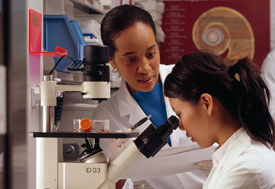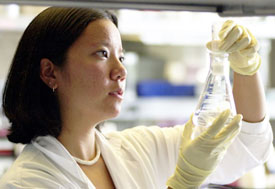US economy benefits from global health research
May / June 2012 | Volume 11, Issue 3

Photo by Rhoda Baer, courtesy NCI/NIH
Researchers put health dollars to work at the NIH
campus in Bethesda, bringing economic benefit to
Maryland.
U.S. global health research funding not only produces humanitarian benefits, improving and saving millions of lives worldwide, but also generates significant domestic economic activity and spurs scientific innovation. For every U.S. dollar spent on global health research and development, 64 cents go directly to domestic-based researchers and product developers, generating jobs, research and technological capacity, and additional investment, according to health advocacy groups.
Since federal research dollars are often heavily leveraged with matching funds, these grants and contracts are catalytic, fueling discoveries that help U.S. scientists remain global leaders in biomedical research. The NIH - the world's largest government health research organization - plays a major role, developing scientific expertise and building research capacity that drive the economy.
"Investment in the NIH continues to bring new ways to cure disease, alleviate suffering, and prevent illness. Furthermore, it generates new economic activity and employment in the communities that receive its funds," NIH Director Dr. Francis S. Collins stated in congressional testimony.
Federal research investment offers significant return
As an example, Collins cited data that shows every $1 of NIH health research funding, including for global health, returns $2.21 in goods and services in just one year. In addition, every NIH grant creates an average of seven high-quality jobs, according to an analysis by Families USA.
Global health improvements generated by the U.S. research investment continue to mount. The U.S. contributed to 24 of the 45 new global health products developed worldwide between 2000 and 2010, according to Global Health Technologies Coalition (GHTC) in its recent report, "Saving Lives and Creating Impact."
Among these products are a more effective diagnostic test for tuberculosis, a new vaccine to ward off meningitis and the next generation of HIV therapies. Today, the pipeline of 365 products in development is the largest ever.
The NIH's new
National Center for Advancing Translational Sciences (NCATS) is working to speed progress in bringing additional drugs to patients, by
establishing a new collaboration between researchers and pharmaceutical companies. The companies will share their data on 20 compounds that didn't work against their target diseases but might against different targets. A past example is the drug azidothymidine, which was ineffective against cancer but useful against HIV.

Photo by Linda A. Cicero/Stanford News Service
NIH funding boosts California's economy by
supporting scientists' salaries and research
projects, such as those conducted in this
Stanford University Medical School dermatology
lab.
Public support is strong for global health research
U.S. citizens recognize that their country benefits from progress made against global diseases, such as HIV/AIDS, according to polls conducted by Research!America. Furthermore, a majority believes that the domestic economy also profits from global health research funding, not least in generating products, capacity and expertise that keep their country competitive in the world economy.
"Americans see science as a solution. . . to our economic woes and health challenges," said Research!America President and CEO Mary Woolley. In a recent poll, 78 percent of respondents said that for the sake of their country's economic competitiveness and prosperity, it's important the U.S. continues to lead in the sciences. A related poll showed half of respondents said they would be willing to pay $1 per week more in taxes if they knew it would go to medical research.
"Public support stems in part from awareness and local pride, from knowing that life-saving medical discoveries are emerging right here close to home," Woolley said. "It also comes from knowing that federal and state tax dollars are flowing into one's own communities, creating jobs and economic activity, private sector investment and business activity."
Interestingly, less than one penny of every U.S. health dollar goes toward global health research and development, according to Research!America.
2011 NIH research funding
| California | $3,535,284,000 |
| New York | $2,041,382,000 |
| Maryland | $1,687,676,000 |
| Illinois | $779,187,000 |
| Georgia | $463,293,000 |
| New Jersey | $250,728,000 |
Source: Research!America
Find out more about
global health
research information from Research!America,
including economic impact data by state.
Every state benefits from federal research
All U.S. states receive federal grants and contracts for health research, with the bulk coming from the NIH.
California, the largest recipient of federal research funds, has a robust global health sector that contributes significantly to the state economy. About $3.3 billion in NIH grants and contracts supported more than 62,000 jobs in the state in 2010, according to United for Medical Research.
"We need public funding for the basic research, we need private investment in the execution of that research and we need world cooperation in all of the research," Rep. Brian Bilbray, R-CA, said in a Research!America release.
Another state receiving substantial NIH funds is New York, with $2 billion supporting more than 33,000 of the 80,000 life sciences jobs in 2011. The state houses seven of the top 50 American research universities and two of the top 25 medical universities. New York City alone has the largest bioscience workforce in the nation, according to data presented by Research!America.
Rep. Nita M. Lowey, D-NY, noted that her state leverages each federal dollar from global health funding at a 4-to-1 ratio, "stretching each taxpayer dollar even farther." Investing in global health, she said, "is not only the right thing to do, it's the smart thing to do."
NIH's home state, Maryland, contains 50 research-intensive federal institutes and centers that have helped foster about 500 bioscience companies, according to 2010 state data.
"Maryland's life sciences industry continues to be one of our strongest economic drivers, creating high-paying jobs even in tough times and helping to feed, fuel and heal our planet with life-saving discoveries. Together, we can unlock our future potential, while offering moral leadership in an increasingly connected world," Gov. Martin O'Malley commented.

Photo by Norbert von der Groeben/
Stanford School of Medicine
Federal funding drives scientific innovations in
California, including advances in developing human
heart cells made by Dr. Oscar Abilez and his
multidisciplinary team at Stanford University.
Funding cuts could reduce US competitiveness
The enormous investment in global health research and other biomedical areas has propelled the U.S. to its world leadership position. Citizens are overwhelmingly supportive, with 91 percent of Research!America poll respondents saying it is important for the U.S. to maintain its world leadership role in science and innovation.
"Research and development must remain a national priority for our country, to keep healthy the thriving U.S. research enterprise that saves lives and spurs new businesses and jobs throughout the country," said Woolley, whose group urges more global health funding, including for NIH.
Building a cadre of scientists with excellent research skills who are comfortable working in an international context is critical, noted Fogarty Director Dr. Roger I. Glass. "By providing global health research training opportunities for early career U.S. scientists, we are building the next generation of global health leaders and ensuring America will remain at the forefront of scientific discoveries," he said.
However, concern about the U.S. budget deficit makes it unlikely NIH funding will increase or even remain constant. Unless Congress revisits the issue of widespread spending cuts, set to begin in January 2013, the NIH faces an 8 percent drop in its fiscal 2013 budget.
Collins has warned about the drawbacks of cutting NIH funding, not least the risk of diminishing U.S. competitiveness.
"Investments in the biomedical infrastructure, in scientists' ideas, and in workforce training are essential to drive the innovation that will spur America's economic recovery and future growth," he said. "Because of increasing foreign research funding and flat funding for the NIH, the NIH is becoming an increasingly smaller funder of biomedical research relative to our competitors."
More Information
To view Adobe PDF files,
download current, free accessible plug-ins from Adobe's website.